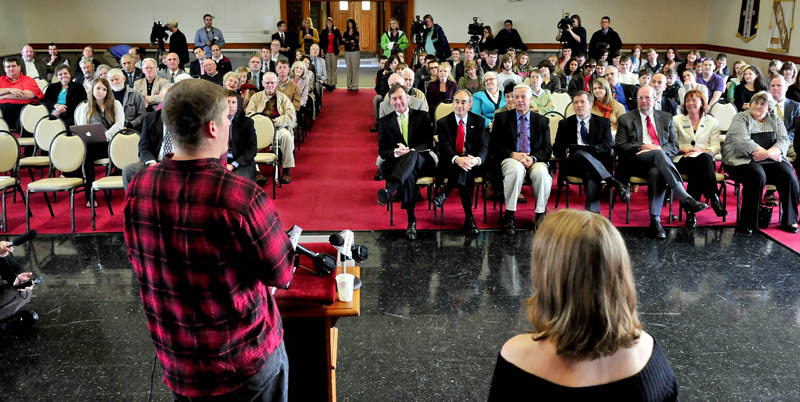FAIRFIELD — Just more than a year ago, Samantha White was a student at Skowhegan Area High School. She was miserable and failing most of her classes when she applied for a spot at the Maine Academy of Natural Sciences.
At Skowhegan, “The only class I did well in was algebra and that’s just because I liked the teacher,” she said Monday morning, the first day of school at the academy. “I don’t know what I would do without this place. It’s my home.”
Monday was the first day of classes for the Maine Academy of Natural Sciences, which is reopening this year as Maine’s first charter high school. The school opened last year as an outdoors education high school on the campus of Good Will-Hinckley, a 121-year-old residential school that served at-risk young people until its core operations closed the summer of 2009 because of financial problems.
Monday was also an important day for charter schools elsewhere in the state — Cornville opened the state’s first charter elementary school with a flag-raising ceremony at 8 a.m.
“This is the first time a charter school is opening in the state of Maine,” said Glenn Cummings, president and executive director of the arts and sciences school. “It is truly a historic day for the state.”
State education commissioner Stephen Bowen said he was very excited to see the academy open as a charter school.
“It is unique because of the population of students it serves — those whose needs haven’t been met by the larger school system,” he said. “There are also natural resource education facilities and partnerships with higher education.”
All students at the academy will be required to take at least one course at adjacent Kennebec Valley Community College, which also owns buildings and land on the Good Will-Hinckley campus.
Academic life will also change as the school adopts a year-round calendar with a four-day school week.
“We’re an agricultural school, so it makes sense,” said White. “Even though it stinks not to have a summer.”
“It’s nice to have three-day weekends all year though,” said Olivia Broderick, 17, a senior who last year initiated a chicken coop project where students hatched chicken eggs. The goal of the project is to raise chickens and collect eggs for the school kitchen.
The Good Will-Hinckley campus, which is also home to the L.C. Bates Museum, has served as a largely privately funded organization since the 1890s when it was founded as a farm and school for boys by Connecticut-born preacher, George Walter Hinckley.
In recent years the school went through many changes revolving around public and private sector funding and a changing student population. Up until 2009, the campus had a private school that served students from around the state. It received state funding for its residential program, which targeted students with emotional and therapeutic needs. In 2009 that school closed with officials attributing it to changes in funding and endowment in conjunction with the economic downturn.
Last year, the Maine Academy of Natural Sciences opened as the state’s first high school to focus on the natural sciences. There were 19 students total and a graduating class of five. The school applied for a charter in May and it was granted by the Maine Charter School Commission on June 29. There are 47 students enrolled this year, more than twice last year’s population.
The Republican-led state Legislature approved the creation of a charter school program in June 2011, making it the 41st state to do so. The law allows only 10 charter schools to be approved in the first decade.
Charter schools are alternative schools that offer more flexebility and creativity with curriculum. Because they receive state funding they are still considered “public” schools although they are relieved of some of the regulations that apply to traditional public schools. There has been some concern that charter schools restrict funding to other district schools because the money allocated for each student follows the student to a charter school.
Jana Lapoint, chair of the Maine Charter School Commission, said this is less of a concern at the academy, which draws students from 27 school districts across the state. The farthest students come from Ogunquit and the Washington County town of Columbia Falls.
“One student leaving to come to a charter doesn’t really lose a lot of money for the district,” Lapoint said. “It’s different in Cornville where a lot of money is coming from the district and going to start a new school.”
She also said that the academy is unique because they have an endowment and also have received more donations than most charter schools receive. On Monday the Harold Alfond Foundation, a philanthropic organization, presented the school with a gift of $1 million. That is in addition to other grants and external funding the school has received.
The money should help to defray the cost of boarding students who live outside of the area, which is also an unusual aspect of the school.
Cummings said that many people assume that charter schools are not held to the same standards as other schools because they might have a non-traditional curriculum. Students at the academy spend three-quarters of their day outside or in project-based learning, said one student, Nicholas Fothergill.
“We have to demonstrate that we have the ability to be academically successful,” Cummings said. “This is still standards-based education.”
Rachel Ohm — 612-2368
rohm@mainetoday.com
Send questions/comments to the editors.



